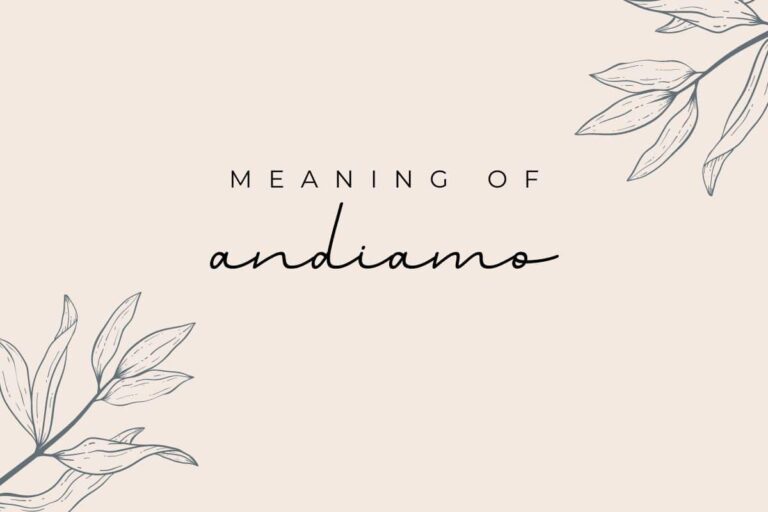Mandarin Chinese Learning Resources — The Ones We Used
This is a collection of the best resources to learn Chinese online — ones we used ourselves.
I speak eight languages (at time of publication). But the language I’m most proud of having learned is Mandarin Chinese.
(If you’re curious how about in which contexts it’s “Mandarin” and in which it’s “Chinese”, check out my article on the complexities of being and speaking Chinese).

In Mandarin Chinese, I got higher than any other level, something which I wouldn’t have been able to do without special effort as it’s quite hard. By the “end” of my formal study I could read a newspaper article on the economy or politics and then discuss it intelligently — in one year.
But I couldn’t have gotten to this level without my excellent teachers. In fact, the main thing I learned through my Chinese studies was the importance of a great teacher. That’s why using italki for a tutor (or finding a great one in person) is still top of our list of recommendations.
Not much has changed in the world of language learning since I started this journey in 1999. There are a few new products, and at this point I have used all of them. Some of the products have existed since the early 2000s. Pleco made the best dictionary then, and it still does today!
The core of our advice on learning languages remains the same:
- Start with pinyin, and move quickly to characters
- Get a teacher and study with them every day, prioritising speaking with them
- Use your own custom word list, and ruthlessly prioritise the things you need to know.
- Learn every word in context
Here are the resources we like. If you have any questions let us know… Chinese is an arduous journey, but as the expression goes —《万事起头难》: The first step is always the hardest.
You might also like 20+ fast and fun facts about Chinese! Including why I call it “Chinese” and you probably say “Mandarin”…
Tip 1: Get a teacher (on italki)
I learned this the hard way, wasting time. Chinese is hard. You need a teacher.
My best tutors, at an academy that has since shut down, and then my in-person tutor I stole from there Feng Laoshi, totally changed how fast I learned Chinese by a factor of roughly five.

If you want to learn to speak a language, you need to actually speak it.
The main regret we have with any language learning process is delaying too long before trying to speak it with people and have a conversation.
Having a conversation exposes every weakness, and reinforces everything in a “natural” scale. You should be really fluent at introducing yourself and talking about daily things. Luckily you do that with a tutor every time!
We’ve written about italki extensively in our review on it, which you should read before using it. Why? Because we don’t want you to waste time!
A few tips we give:
- Get more than one teacher — at least two. There are lots of reasons for this, including that teachers bail, their availability varies, you learn different things from different teachers, and more.
- Don’t assume the most expensive teachers are the best, or that the cheapest tutors are the worst. They might just be getting started and keen for new students!
- Use our rubric for estimating the student retention rate. Do you want a teacher that everyone leaves after one or two lessons?
- Schedule back-to-back interviews with a few teachers first. Find your team, and then build your calendar of lessons.
See more in the guide to using italki.
We also really like italki because it’s all online. No more wasted time in traffic or being late to class (unless you’re just disorganised).
And it’s so easy to filter through teachers and get the ones who have done the most lessons, have the highest reviews and the most reviews.
Use Pleco: The best Chinese learner’s dictionary

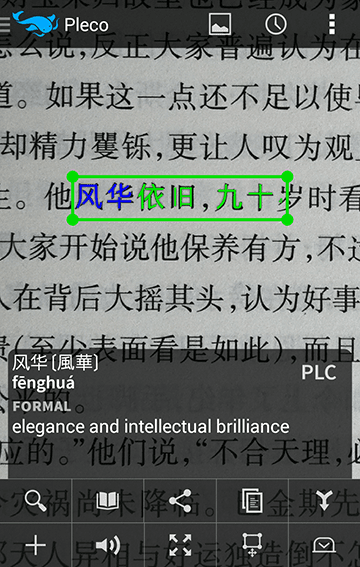

If there is one tool you need to learn Chinese, it’s the Pleco Chinese dictionary.
There’s a free version that’s great, but don’t hesitate about buying the license. It’s the best investment into your Chinese studies you can make.
When I first heard about Pleco I was amazed. An app that makes my Personal Digital Assistant (PDA) into a dictionary? Finally, a reason to buy a PDA!
… Yes that’s right. Pleco has been around for so long it was originally built for PDAs, the predecessors to smartphones.
More than fifteen years later it still is the best Chinese dictionary app. Every time I study a new language I think “Why isn’t there something like Pleco in this language too?”
What we need is more people like Mike Love, the founder and original developer of Pleco. Unfortunately, there’s only one of him.
The free version of Pleco, which works on both iOS and Android, comes with a lot of features, but paying $50-100 for the advanced dictionaries and live OCR features is easily worth it.
Here are some of the killer features you get in Pleco that make it 100% indispensable:
- Example sentences. There are so many example sentences in the Pleco dictionaries that you have no choice but to totally understand what a word means in every context.
- Audio recordings. Invaluable for helping with pronunciation.
- Fully searchable character/word database: You can search by word, by character, by radical… you can break words apart, build them up, find them in sentences — basically you can see a lot of context for every word.
- Optical character recognition. Trying to parse a newspaper? Use the live OCR feature to scan characters and look at the dictionary right away. Yes, Google Translate does this, but that just “translates”… this takes you to the dictionary entry so you can see the exact word, with meaning and examples. It’s great for learning.
- Stroke order entry/display. You can enter characters with your finger, drawing them as you do in real life. Yes, you can do this with Google/Apple keyboards these days, but the Pleco version always works better (and they invented it around five years before big players got around to it). More interestingly, for every character, Pleco can paint it live for you so you can see exactly how it should be written!
There are tons of other features I never used much, but which you might love, like
- In-build flashcard system (it looks really sophisticated)
- Advanced technical languages, for example for your profession
- A “reader” that lets you look through a long Chinese text and click on words you don’t know, including just reading what’s in the clipboard
- Cantonese – more limited support, but useful to have in there!
An Chinese Anki deck — Chinese, Spoon-Fed ($2)
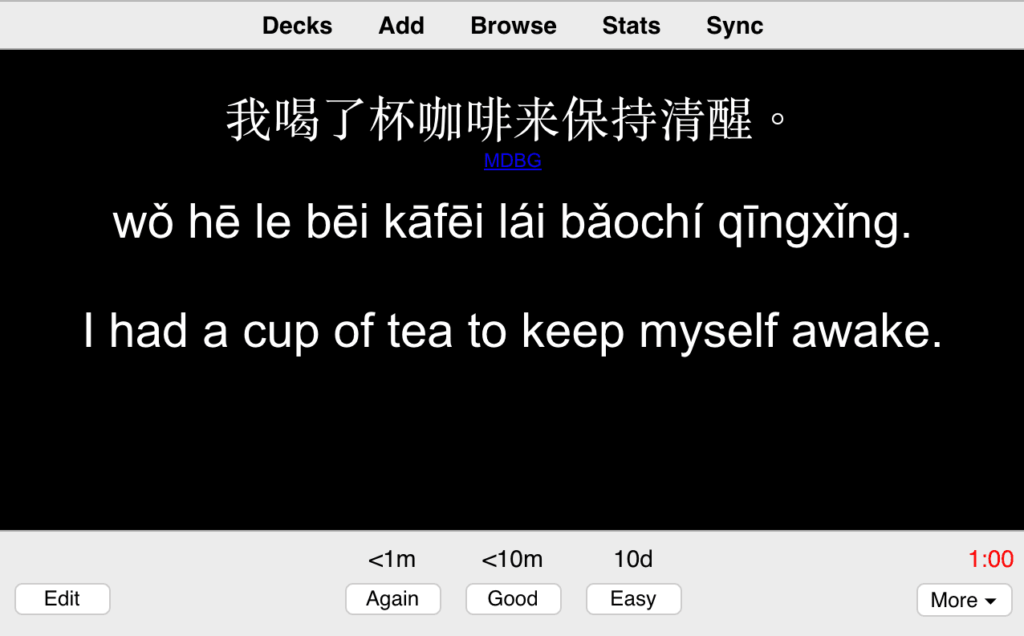
The Chinese Spoon-Fed deck used to be a free deck on Anki. Actually it still is, but the author made so many improvements he decided it’d be worth… a paltry $2.
This is a bargain — I think it’s worth $25 at least. The deck is thousands of Chinese words and sentences with full audio and transliteration. You can learn (or brush up on) Chinese almost exclusively using this deck.
I highly recommend it. It’s worth so much more than the $2. I’m using it to refresh my rusty Mandarin that I haven’t used extensively in a number of years.
Warning — It’s a 100MB+ file and it may take a while to sync between your desktop and phone.
Glossika: Listen and repeat Chinese sentences and crush pronunciation

Listen and repeat sentences from a sentence bank.
I don’t like Glossika in every language, but I do like it in Chinese.
In 2006, when I got started with Mandarin Chinese, I actually used a course that inspired Glossika called Pimsleur. It really helped me sound natural.
Go read our full guide on how to use Glossika most effectively. It’s so much more than just a sentence bank. Read the guide before you bite the bullet — you’ll get a lot more out of it.
Skritter: Master writing Chinese characters
Read our full review of Skritter here — it’s how I learned 2,500+ characters.
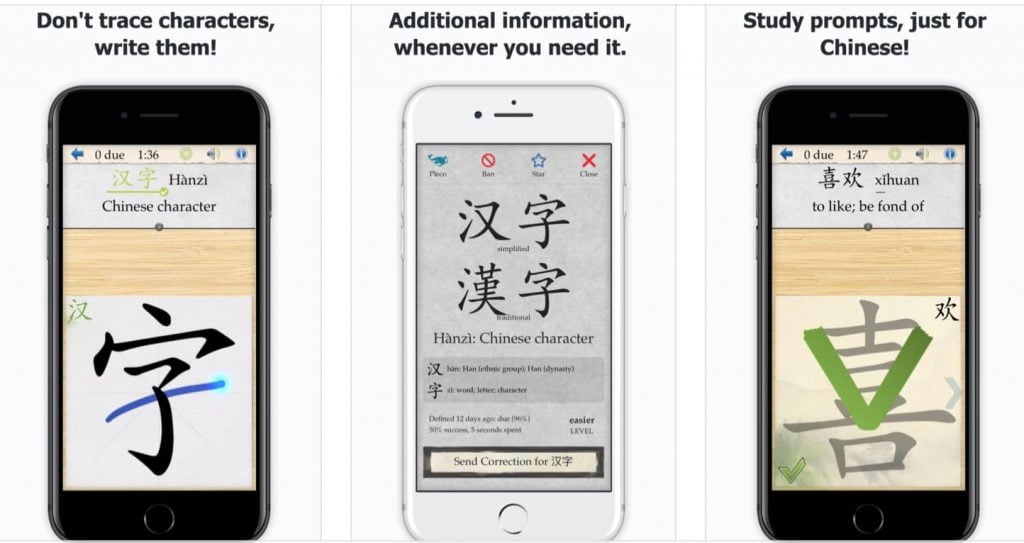
We don’t recommend apps as the best method of general language learning. But I like apps for very specific things.
In this case, I like Skritter because it’s an awesome way of hammering in Chinese characters (or Japanese Kanji, for that matter).
My teachers would always think it was funny how my handwriting looked like type. But I remembered every character, every stroke. They loved it!
Skritter is just a flashcard system, but with an important difference: it forces you to trace out every character by hand.
Even better — use it with a touch-screen or tablet and get a stylus/pen for it. This will train your muscle memory a lot better. (In the early days before everyone had touch-screens or tablets I used to use Skritter with an external tablet I connected to my computer.)
I used Skritter in 2012, and I still recommend it today, more than ever. It has no competition. It’s fun, it’s affordable and it’s indispensable.
In case you’re thinking “I’ll never have to write! I just type or use my phone! I don’t need this” — yes, you’re probably right. But learning to write will 10x your ability to read, especially hand-written notes and menus.
Also, it’s really cool to just write a few characters like “I’ll be back in five minutes” or “I bought these cakes for everyone — please eat them!”. Be a weapon.
MDBG: An amazing online dictionary
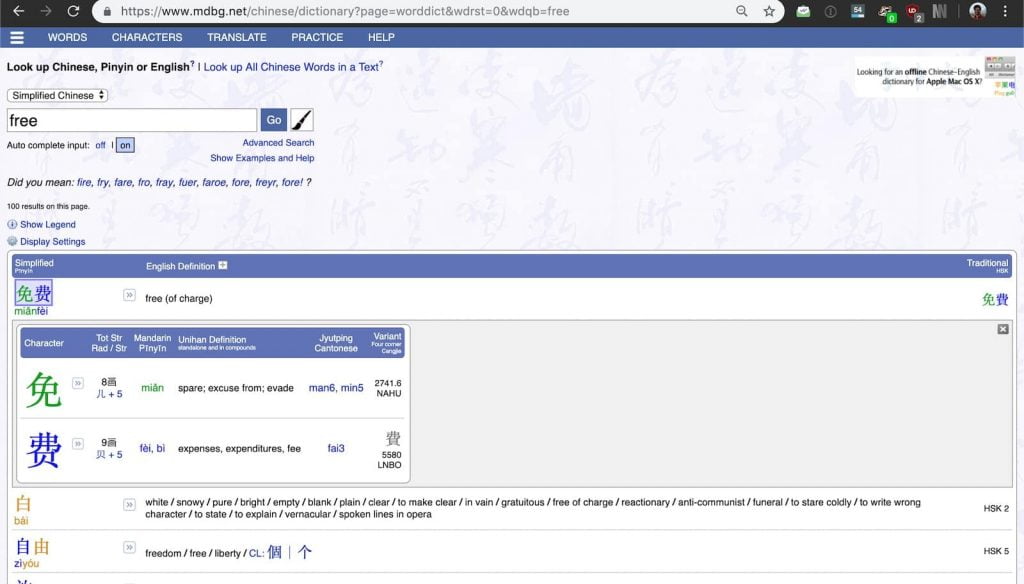
This dictionary is so good I’m constantly saddened it doesn’t exist for other languages. And it’s free!
Since Pleco is only for mobile devices, you need a desktop dictionary. And MDBG is the best one out there.
MDBG has
- Really good wildcard support. Like look for *铁* for all words and phrases with that character in it
- Sample sentences, via another website “Jukuu”. They’re nowhere near as good as the ones in Pleco, and often seem machine-translated, but it’s a start
- Easy viewing of traditional/simplified characters, plus Cantonese pronunciation
It also has a really large number of idioms and sayings. Try looking for the word “idiom” in there — it will return you hundreds, it’s amazing. Chinese is really rich in idioms, so learn a few.
Zhongwen: Pop-over Chinese Dictionary
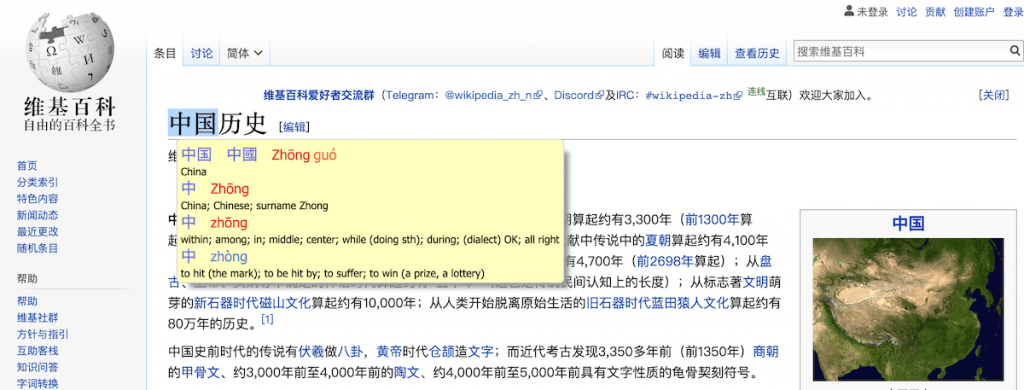
A pop-up dictionary makes reading Chinese on the web a breeze.
Once you’ve learned a bit of Chinese, reading it online becomes a quick way of learning new words or reinforcing vocabulary. But if you need a quick reminder about anything, a pop-up dictionary is the best way.
This is a Chrome extension, but similar ones exist for other browsers.
And… any good textbook (that your teacher tells you to get)
I don’t have a good textbook recommendation. Why? Because every teacher has different suggestions, and Chinese is best learned with a teacher.
I don’t recommend self-learning Chinese. You might be able to do it. But even though it was my sixth language and I’m someone who’s “good at languages”, I found my pace of learning quadrupled with the right teacher.
For this reason, unlike for other languages, I don’t recommend using something like Colloquial or the Teach Yourself series. It might work as a supplement, but it’ll be hard to use it alone.
There are many, many texts for Chinese, which can teach you any number of things including
- Learning to read the news
- Developing your listening comprehension
- Normal everyday dialogue
- Business-focused conversations
- Poetry and history
Really any text is fine. Just find the right teacher, tell them about your interests, and they’ll take care of you.




